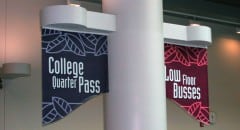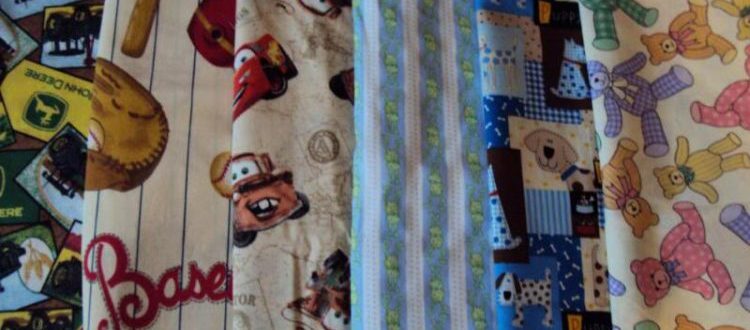It might be a misnomer in some ways to title this article “How To Make A Cloth Banner” because honestly, I don’t even know how to make a one! Well, that’s not exactly true, but I don’t really know how to make a cloth banner from scratch.
I am not a seamster, although I did sew a shirt with my Mom’s help when I was 14, and I still put buttons back on my shirts when they pop off (no jokes here please). But I have seen it done before when I used to have a sub-contractor who was amazing at making appliquéd banners for our client, Washington State University, back in 2001 and 2002. But they were time consuming and very expensive too.
OK, I admit it…I really can’t teach you how to create a fabric display! Maybe you can teach me?
 If you can find scrap fabric and know how to sew really well, you could probably teach me how. However, very few people know how to sew like your Grandma or your Mom, so even finding someone to teach you is like finding a needle in a haystack. And there is less and less call for these types because technology has enabled us to make them that are considerably less than half the cost of appliqué cloth banners, and they look phenomenal. That’s why the title of this article is a misnomer in one sense. Of course, unless you have 50 or 100 grand to drop on a new digital dye sublimation inkjet printer, you’ll probably want to order a banner from a dye sub printer.
If you can find scrap fabric and know how to sew really well, you could probably teach me how. However, very few people know how to sew like your Grandma or your Mom, so even finding someone to teach you is like finding a needle in a haystack. And there is less and less call for these types because technology has enabled us to make them that are considerably less than half the cost of appliqué cloth banners, and they look phenomenal. That’s why the title of this article is a misnomer in one sense. Of course, unless you have 50 or 100 grand to drop on a new digital dye sublimation inkjet printer, you’ll probably want to order a banner from a dye sub printer.
So, really, I do know how to make a banner display if I have the right equipment…and it’ll look better than any other you’ve ever seen
Now the issue of making these displays now is simplified, at least for a graphic designer. Literally, any image, photograph, illustration, or logo can be reproduced brilliantly using dye sublimation printing. Even if you’re an amateur designer and have a copy of Photoshop from Adobe, you can put together a really nice design using photos and the like and send it to dye sublimation printer who knows how to make a cloth banner, and they’ll return to you a continuous tone banner or poster or flag with colors like you only see in photographs, because the print process is able, with dye, heat, and pressure, to create the beautiful continuous tones that have been available for the past several years.
Simple Explanation of How to Make a Cloth Banner Using the Dye Sublimation Printing Process
So, now that you know how to make one, you may be wondering “how does this process work?” First, you have to use a fabric that has polymers in it. What are polymers? I don’t know, but the fabric has to have them, and I do know that polyester and nylon have them, so that’s what we use for sublimation press. Next, you need dye. The four colors used are cyan, magenta, yellow, and gray (or grey if you’re British). Using a handy-dandy dye sub inkjet printer, you simply buy cartridges of these four ink colors. Almost. There are two more very important ingredients when you’re learning the production using heat, and pressure.
The Process
OK…so here’s the full process. First, you press your image (or your pre-approved graphic designer’s image) onto a special paper that comes in large rolls, usually 60″ or 120″ in width and really long. Then you marry the paper to equivalent width polyester cloth and run it through heat rollers that take care of the heat and pressure ingredients. The dye turns gaseous with the heat and the pressure melds the dye with the fabric, literally fusing the color with the fabric into one continuous tone. You can finish it by hemming, creating pole pockets for the banner to slide over, or just hot knife trimming off the excess cloth so you can finish it or not finish it, depending on what you want for a finished product. Now you know how the way we do it!
There are lots of uses for polyester fabric displays, so many types of material have been created from polyester. Most people think of Dad’s old disco suit from the ’70’s when they think of polyester, but it’s not the same fabric as it was 40 years ago. Well, it is the same, they’ve just figured out how to make it appear like sheer nylon, cotton, spandex, or silk, to name a few. They even still have the knit, but you won’t recognize it unless you print some of those garish ’70’s patterns on it. It is actually one of the best color carrier fabrics available to a printer as it is more dense than some of the other fabrics which tends to lose some color clarity due to the lightness and airiness of the material.
If you’re interested to learn more about how to make a cloth banner, click here.
Good Read! Can I get a quote NOW!?
Popular Posts:




